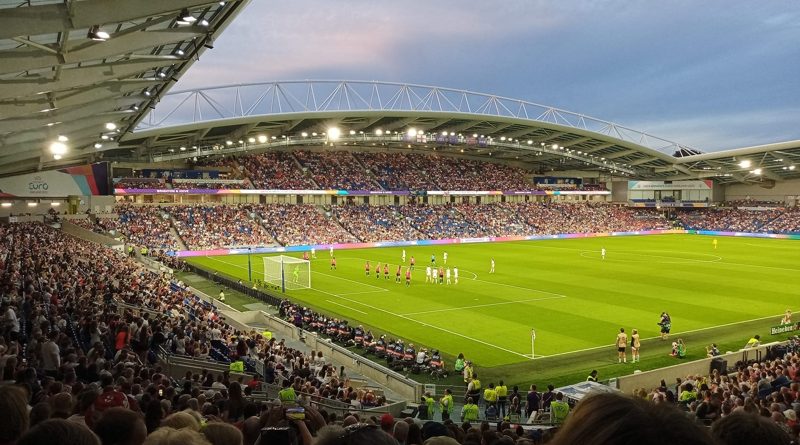Have Brighton done enough to capitalise on success of Lionesses?
Women’s football has never been more popular in England. The Lionesses winning Euro 2022 on home soil at Wembley made the players household names and caused interest and participation in the sport to explode.
England’s agonising World Cup final defeat to Spain last summer drew a peak audience on the BBC of 12 million viewers, higher than the men’s Wimbledon final.
Attendances at games meanwhile continue to grow. The biggest WSL sides regularly pack more than 30,000 into their respective club’s home stadiums when used.
Arsenal lead the way by frequently selling out the Emirates. And anytime the Lionesses return to Wembley, you can guarantee a crowd in excess of 80,000.
The team at OLBG have delved into the figures behind the increasing popularity of women’s football. Their Female Football Report 2024 looked at this record-breaking viewership, online search frequency, and social media trends.
Included in the report were a comparison of average attendances between the 2021-22 season and the 2022-23 campaign, essentially looking at what happened to WSL crowds post-England being crowned European champions.
Brighton Women enjoyed a 94 percent increase, which on the face of it looks very impressive. Yet it was only the ninth largest in the WSL, ahead of just West Ham United and Leicester City.
Reading finished rock bottom of the league in 2022-23 and still managed to increase their attendance by 182 percent.
Spurs endured a poor season to end the campaign in ninth but their crowds went up by 135 percent. Everton secured the third-largest increase of 192 percent and they were slap bang in mid table.
It makes the Albion’s 94 percent appear meagre in comparison, adding weight to the claims of those who say Brighton have not done enough to capitalise on the success of the Lionesses by attracting new supporters and growing the fan base of the women’s team.
Whereas the men’s side are known for being one of the best-run clubs in the country, it appears something of a different story on the women’s front.
Current interim head coach Mikey Harris is the fifth different manager to lead Brighton Women since England won the Euros.
Hope Powell resigned after an 8-0 defeat to Spurs. Powell’s replacement was Jens Scheuer, who lasted only six games before he left by mutual respect.
Amy Merricks had two spells in caretaker charge either side of Powell and Scheuer before Mel Phillips arrived. Phillips was sacked in January after less than a year at the helm.
Another permanent appointment is expected to take over from Harris at some point, which will make it six head coaches in less than two years.
Tony Bloom’s stated ambition for Brighton Women on-the-pitch of becoming an established top four side seems a million miles away, compared to the men who have achieved his initial target of top 10 and a European campaign.
Success on the pitch obviously drives more bodies through the turnstiles. The constant chopping and changing of managers does nothing to help that and highlights mistakes being made at board level.
And yet as already mentioned, Reading were relegated and still increased attendances by almost double the percentage Brighton Women managed in 2022-23.
Current bottom side Bristol City have won just once in the current WSL season so far and look certain to end the season with a relegation of their own. The Robins’ average attendance so far? 7,687, compared to 3,494 for Brighton.
City have not needed a winning team to get people along to Ashton Gate, even to watch a side who the Albion were able to score seven times past in the West Country earlier this month.
How have the Robins done it? The key couple of words in that preceding sentence are Ashton Gate. City play all their games at their home stadium and the results speak for themselves.
Brighton in contrast have used the Amex twice since the Lionesses won the Euros. Once in the current campaign against Spurs and once last season versus Reading.
Another game had been scheduled to take place in 2022-23 with Aston Villa, only for it to be postponed following the death of The Queen.
Amongst the reasons given by the club for not playing more games at the Amex are that demand is not there. Which may well be true if you opt to host the likes of Reading, Spurs and Villa – games which are never going to attract attendances approaching the apparent breakeven figure of around 15,000.
Those three clubs have a single Euros winner between them in Villa’s Rachel Daly; not withstanding Bethany England at Spurs, although she did not play a single minute at the championships.
Use the Amex though against Arsenal and see how many people turn up to watch Leah Williamson, Beth Mead and ex-Albion striker Alessia Russo.
It will be a lot, as seen when Brighton Women set their record attendance at the Broadfield hosting the Gunners last season. That number was then beaten with the first ever sell out at Crawley, also against Arsenal in November.
There was a big crowd at the Broadfield when Mary Earps and Ella Toone rocked up with Manchester United, despite the game being a 7:45pm kick off on Bonfire Night. United are another opponent who would draw a decent attendance to Falmer.
Using the Amex when Brighton Women face teams with little-to-no star power and not when Lionesses are on show is an interesting approach, to say the least.
Get people through the doors at Falmer lured in by Earps, Toone, Russo and Mead. Give them a brilliant experience.
Make them want to come back for more and you grow the fan base, as at least nine other WSL teams have done more successfully than the Albion since 2022.
The other argument about more regular use of the Amex is cost and wear-and-tear on the pitch. Other clubs though manage it. Arsenal Women regularly play at the Emirates, which holds at least as many matches as the Amex will this season.
And then there is Bristol City (again). Every WSL game at Ashton Gate. 23 Championship games for the men. And at least 20 rugby union games on the same pitch as it is also the home of Bristol Bears.
Nobody is saying that the Amex should be used every week by the Women. But is it really that difficult to find space in the calendar to fit in three or four home matches per season?
Why, for example, could last Sunday’s WSL game against Manchester City not have been switched? The pitch would have two weeks to recover before the visit of Arsenal on Saturday 6th April.
The Amex factor combined with Chloe Kelly, Lauren Hemp and Alex Greenwood being present could have easily pulled in a record WSL crowd to the Amex.
Brighton have rightly been lauded for their commitment to women’s football by planning to build a WSL-specific stadium in the city.
But as the 12-year wait between identifying Falmer as a site for a new home and the Amex opening its doors shows, that is easier said than done. A new ground could be five, six, seven years down the line. What about the here and now?
Ultimately, the biggest barrier to increasing attendances at Albion Women games is playing them 20 miles away in Crawley at a stadium which is difficult to reach via public transport from Brighton.
Following the lead of Bristol City and playing every home match at the Amex is admittedly unrealistic, but more can surely be done to play a greater number of WSL games at the Amex and against bigger clubs who will pull in larger crowds.
Otherwise, Brighton will continue to trail the rest of the WSL when it comes to attracting new fans. The Albion are missing an opportunity.




